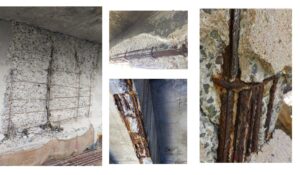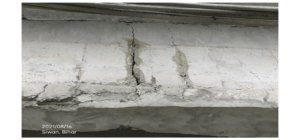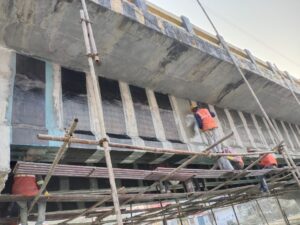Corrosion in reinforcement is one of the most important and prevalent mechanisms of deterioration for Reinforced Concrete Structures.
Corrosion process:
In concrete, the presence of abundant amount of calcium hydroxide and relatively small amount of alkali elements, such as sodium and potassium, gives concrete a very high alkalinity with pH of 12 to 13. It is widely accepted that, at the early age of the concert, this high alkalinity results in the transformation of a surface layer lf the embedded steel to a tightly adhering film, that is comprised of an inner dense spinal phase in epitaxial orientation to the steel substrate and an outer layer of ferric hydroxide. As long as this film is protected, it will keep the steel passive and protect it from corrosion.
When a concrete are often exposed to atmosphere, chloride ions from these will slowly penetrate into the concrete, mostly through the pores in the hydrated cement paste. The chloride ions will eventually reach to the steel and then accumulate to beyond a certain concentration level, at which the protective film is destroyed and the steel begins to corrode, when oxygen and moisture are present in the steel concrete interface.
Corrosion: Structural effects:
In the case of concrete structures the first direct effect of the reinforcement corrosion is its section decreases due to the corroding process. Iron oxide (Rust) resulting reinforced concrete structures and their effect induces internal stresses in the concrete, which may lead to cracking or even spalling of concrete.
Induced Cracking of the concrete
Corrosion also may reduce the steel elongation at maximum load, affection the structure.
Accordingly, reduction of structural capacity of reinforced concrete elements affected by rebar corrosion is mainly due to following three main phenomena, which are direct consequence of corrosion:
- Reduction of rebars section due to corrosion.
- Reduction of bond strength.
- Loss of concrete integrity due to cover cracking and spalling.
However corrosion of reinforcing steel can occur by two major situations, they include
- Carbonation.
- Chloride contamination.
The removal of the passive film from reinforcing steel leads to the corrosion process. Chloride ions within the concrete are usually not distributed uniformly. The steel areas exposed to higher concentrations of chlorides start to corrode, and breakdown of the oxide film eventually occurs. In other areas the steel remains passive.
The rate of carbonation in concrete is directly dependent on the water cement ratio of the concrete i.e., higher the ratio the greater is the depth of carbonation in the concrete
Causes for failures:
The following are the major causes for failures of structures:
Structural deficiency due to defects in construction, use of inferior and substandard materials, poor workmanship, and negligence in quality control and supervision.
- Damages caused due to fire, foods, earthquakes, etc.
- Chemical deterioration and marine environments.
- Damages caused due to abrasion, wear and tear impact, dampness, etc.
- Movements of concrete caused due to settlements of foundation, thermal expansion etc.
MATERIALS FOR REPAIR
The materials used for concert repair are generally cement based or Epoxy based. They are,
- Cement/Sand mortars
- Polymer Latex
- Epoxy Resins
- Polyester Resins
STRUCTURAL REPAIR BASED ON EXTENT OF DAMAGE
The structural repairs to be carried out in corrosion affected reinforced concrete structures to enhance its service life can be classified as follows:
1. Repairs to spallen concrete portions (steel and concrete)
(a). Cement based repairs
(b). Resin based repairs
2. Large volume repair
(a). Poured concrete
(b). Prep laced concrete
3. Sealing of cracks
(a). Cracks with no further movements expected
(b). Cracks with further movements expected
4. Surface coatings
5. Dry packing
Repair of a severely corrosion damaged member, where cover
Concrete has spallen and reinforcement (reduced in cross-sectional area) has been exposed.
Step 1
The repair process is started by cutting away all the loose and deteriorated concrete until the hard core is reached preferably behind the corroding reinforcement.
Step 2
All exposed reinforcements must be thoroughly cleaned. Loose rust or any contamination is removed by abrasive blast cleaning. Wire brushing by hand is not usually effective.
Step 3
The portions of steel bars severely corroded require replacement. This is achieved by cutting away the corroded portions and replacing with new bars of the same type and size, either welded or tied to the existing bars.
Step 4
After the corrosion affected bars are replaced in position, immediately a protective primer (Zinc, neat resin or any other suitable coating) is applied. The primer chosen should be such that it should good adhesive strength and good adhesion to subsequent repair layers.
Step 5
In order to build up the section, either cement based repair, or Resin based repair can be carried out.
Typical repair procedure for corrosion damaged concrete
Cement based repairs:
Step 6
(i). The slurry (bonding coat) is applied to all concrete surfaces to which bond is required and the patching mortar (readily available in pre-weighed packets) is applied, while the slurry is still tacky. (Care should be taken to wit the concrete surface before the application of the material but there must be no standing water left on the surfaces).
(ii) After the prepared surfaces have been coated with bonding agent or a coating of neat cement slurry, the repair material consisting of 1:3(cement and sand) is applied in layers not exceeding 20mm thick. Each layer is to be keyed to receive the succeeding layers.
The outer layers of cement should not be thicker than the inner layers. This is required, in order to prevent failure due to shrinkage stresses.
It should be ensured that the cement-based materials used in repairs do not dry out quickly. The method is curing depends on the local conditions. Water soaked covers and curing membranes are common ways of protection.
Resin based repairs
Step 7
As usual, the priming coat is applied over the prepared surfaces to protect the surfaces. The interval between coats should not be too long; otherwise there will be bond failure. Resin-based materials cure by exothermic chemical reaction immediately, when the constituents are mixed. It is essential that the materials should be well compacted to become impermeable, because they do not protect the steel by alkalinity.


